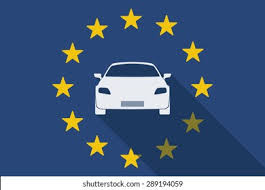
Car sales in Europe rose sharply in July, delivering the industry’s best monthly performance since April 2024. Incentive schemes, consumer demand for hybrids, and aggressive pricing strategies combined to lift the market despite economic uncertainty. At the same time, China’s BYD overtook Tesla in monthly sales, highlighting the rapid reshaping of Europe’s electric vehicle sector.
Incentives and Hybrids Drive Market Growth
Registrations of new vehicles across the European Union, the United Kingdom, and the European Free Trade Association markets rose to more than 1.09 million in July, an increase of nearly 6% compared with a year earlier. This marked the third consecutive month of gains, suggesting that policy measures and evolving consumer preferences are helping offset headwinds such as inflation and tighter credit conditions.
One of the most significant contributors to July’s surge was the revival of plug-in hybrid and hybrid electric models. Registrations of hybrids rose by more than half year-on-year, while plug-in hybrids saw their strongest jump since early 2023. Many buyers viewed these technologies as practical steppingstones toward full electrification, offering lower emissions without the need for extensive charging infrastructure.
Battery-electric vehicles also enjoyed a strong boost. July’s figures represented the most substantial increase in nearly a year, driven by a mix of new model launches, expanding charging infrastructure, and government-backed incentives. Germany stood out in particular. Following the rollout of its new incentive scheme earlier this year, registrations of fully electric cars rose by almost 60% in July, while plug-in hybrids climbed by more than 80%.
Southern and Central European markets also reported robust gains. Spain posted growth of more than 17%, driven by demand for compact family cars and hybrids. Austria, supported by both consumer subsidies and corporate fleet purchases, saw registrations climb by more than 30%. Poland likewise recorded a strong double-digit increase. These results contrasted with declines in France, Italy, and the United Kingdom, where weaker consumer confidence and a more cautious stance on incentives weighed on sales.
The overall picture pointed to a market increasingly shaped by incentives and affordability. Consumers showed a preference for models that balanced price competitiveness with lower running costs, reinforcing the importance of policy support in driving demand during periods of economic strain.
BYD Surges Ahead of Tesla
Alongside the broader sales recovery, July highlighted an important shift in the balance of power within Europe’s electric vehicle market. Tesla, long the dominant force in battery-electric sales, recorded another sharp decline. Its registrations fell by more than 40% compared with a year earlier, reducing its market share below 1%. This marked the company’s seventh consecutive month of losses in Europe.
BYD, by contrast, achieved spectacular growth. Its sales jumped by more than 200%, allowing the Chinese automaker to capture a larger market share than Tesla for the first time in Europe. This surge was driven by several factors. BYD’s strategy of offering competitively priced models undercut many rivals, appealing to middle-income European households that found Tesla’s vehicles increasingly expensive. The company also benefited from introducing multiple models tailored to different consumer segments, from compact electric hatchbacks to larger SUVs.
The price gap between BYD and Tesla played a decisive role. BYD’s entry-level models are often priced significantly lower than Tesla’s, while still offering modern features such as long-range batteries, advanced safety systems, and digital connectivity. For European consumers facing high borrowing costs and inflationary pressures, the appeal of lower upfront costs was decisive.
Another factor behind BYD’s success is its vertical integration strategy. By producing its own batteries and controlling much of its supply chain, BYD has been able to keep costs lower and shield itself from supply bottlenecks that affected other automakers. This advantage has enabled the company to expand rapidly in markets where affordability is critical to capturing new buyers.
Tesla, meanwhile, has been challenged by an aging model lineup and growing competition. The lack of fresh mid-range vehicles, combined with the high cost of its flagship models, left the company exposed at a time when European buyers are increasingly value-conscious. While Tesla remains a major global player in the premium EV segment, its European decline underscores the competitive threat posed by emerging brands such as BYD.
Traditional European automakers also registered gains in July, although at a slower pace. Volkswagen recorded growth of more than 11%, supported by its expanding range of electric and hybrid models. Renault likewise posted nearly 9% growth, buoyed by demand for smaller cars and plug-in hybrids. Stellantis, however, reported a modest decline, highlighting the uneven performance across Europe’s legacy automakers.
Challenges for the European Auto Industry
While July’s results were encouraging, they also revealed the complex challenges facing Europe’s car industry. Policymakers are pushing aggressively toward electrification, with a target of phasing out new combustion-engine cars by 2035. For manufacturers, this has created a race to adapt production lines, invest in battery technology, and secure raw materials, all while keeping vehicles affordable for consumers.
Competition from Chinese brands is intensifying. Companies like BYD are not only competing on price but also improving the quality and range of their vehicles, reducing the historical gap between budget and premium models. As a result, European automakers face the dual challenge of meeting strict regulatory requirements while defending market share against highly competitive newcomers.
Trade tensions add to the uncertainty. Tariffs on Chinese electric vehicles and potential retaliatory measures could reshape the competitive landscape, affecting both prices and availability. Meanwhile, U.S. tariffs on European exports have created further complications for multinational manufacturers.
Consumer confidence remains another wildcard. While July demonstrated that demand can be stimulated through incentives and attractive pricing, households across Europe continue to face high living costs, and financing remains expensive. If broader economic conditions weaken further, sustaining current sales momentum could prove difficult.
Nevertheless, July’s sales highlighted that targeted government policies and competitive pricing strategies are powerful tools to support the transition to electric mobility. The rise of BYD at Tesla’s expense illustrates how quickly the competitive dynamics of the market can shift when affordability becomes a decisive factor. For Europe’s automotive industry, the month offered both reassurance and a warning: demand exists, but winning it requires agility, innovation, and above all, accessible pricing.
(Source:www.investing.com)
Incentives and Hybrids Drive Market Growth
Registrations of new vehicles across the European Union, the United Kingdom, and the European Free Trade Association markets rose to more than 1.09 million in July, an increase of nearly 6% compared with a year earlier. This marked the third consecutive month of gains, suggesting that policy measures and evolving consumer preferences are helping offset headwinds such as inflation and tighter credit conditions.
One of the most significant contributors to July’s surge was the revival of plug-in hybrid and hybrid electric models. Registrations of hybrids rose by more than half year-on-year, while plug-in hybrids saw their strongest jump since early 2023. Many buyers viewed these technologies as practical steppingstones toward full electrification, offering lower emissions without the need for extensive charging infrastructure.
Battery-electric vehicles also enjoyed a strong boost. July’s figures represented the most substantial increase in nearly a year, driven by a mix of new model launches, expanding charging infrastructure, and government-backed incentives. Germany stood out in particular. Following the rollout of its new incentive scheme earlier this year, registrations of fully electric cars rose by almost 60% in July, while plug-in hybrids climbed by more than 80%.
Southern and Central European markets also reported robust gains. Spain posted growth of more than 17%, driven by demand for compact family cars and hybrids. Austria, supported by both consumer subsidies and corporate fleet purchases, saw registrations climb by more than 30%. Poland likewise recorded a strong double-digit increase. These results contrasted with declines in France, Italy, and the United Kingdom, where weaker consumer confidence and a more cautious stance on incentives weighed on sales.
The overall picture pointed to a market increasingly shaped by incentives and affordability. Consumers showed a preference for models that balanced price competitiveness with lower running costs, reinforcing the importance of policy support in driving demand during periods of economic strain.
BYD Surges Ahead of Tesla
Alongside the broader sales recovery, July highlighted an important shift in the balance of power within Europe’s electric vehicle market. Tesla, long the dominant force in battery-electric sales, recorded another sharp decline. Its registrations fell by more than 40% compared with a year earlier, reducing its market share below 1%. This marked the company’s seventh consecutive month of losses in Europe.
BYD, by contrast, achieved spectacular growth. Its sales jumped by more than 200%, allowing the Chinese automaker to capture a larger market share than Tesla for the first time in Europe. This surge was driven by several factors. BYD’s strategy of offering competitively priced models undercut many rivals, appealing to middle-income European households that found Tesla’s vehicles increasingly expensive. The company also benefited from introducing multiple models tailored to different consumer segments, from compact electric hatchbacks to larger SUVs.
The price gap between BYD and Tesla played a decisive role. BYD’s entry-level models are often priced significantly lower than Tesla’s, while still offering modern features such as long-range batteries, advanced safety systems, and digital connectivity. For European consumers facing high borrowing costs and inflationary pressures, the appeal of lower upfront costs was decisive.
Another factor behind BYD’s success is its vertical integration strategy. By producing its own batteries and controlling much of its supply chain, BYD has been able to keep costs lower and shield itself from supply bottlenecks that affected other automakers. This advantage has enabled the company to expand rapidly in markets where affordability is critical to capturing new buyers.
Tesla, meanwhile, has been challenged by an aging model lineup and growing competition. The lack of fresh mid-range vehicles, combined with the high cost of its flagship models, left the company exposed at a time when European buyers are increasingly value-conscious. While Tesla remains a major global player in the premium EV segment, its European decline underscores the competitive threat posed by emerging brands such as BYD.
Traditional European automakers also registered gains in July, although at a slower pace. Volkswagen recorded growth of more than 11%, supported by its expanding range of electric and hybrid models. Renault likewise posted nearly 9% growth, buoyed by demand for smaller cars and plug-in hybrids. Stellantis, however, reported a modest decline, highlighting the uneven performance across Europe’s legacy automakers.
Challenges for the European Auto Industry
While July’s results were encouraging, they also revealed the complex challenges facing Europe’s car industry. Policymakers are pushing aggressively toward electrification, with a target of phasing out new combustion-engine cars by 2035. For manufacturers, this has created a race to adapt production lines, invest in battery technology, and secure raw materials, all while keeping vehicles affordable for consumers.
Competition from Chinese brands is intensifying. Companies like BYD are not only competing on price but also improving the quality and range of their vehicles, reducing the historical gap between budget and premium models. As a result, European automakers face the dual challenge of meeting strict regulatory requirements while defending market share against highly competitive newcomers.
Trade tensions add to the uncertainty. Tariffs on Chinese electric vehicles and potential retaliatory measures could reshape the competitive landscape, affecting both prices and availability. Meanwhile, U.S. tariffs on European exports have created further complications for multinational manufacturers.
Consumer confidence remains another wildcard. While July demonstrated that demand can be stimulated through incentives and attractive pricing, households across Europe continue to face high living costs, and financing remains expensive. If broader economic conditions weaken further, sustaining current sales momentum could prove difficult.
Nevertheless, July’s sales highlighted that targeted government policies and competitive pricing strategies are powerful tools to support the transition to electric mobility. The rise of BYD at Tesla’s expense illustrates how quickly the competitive dynamics of the market can shift when affordability becomes a decisive factor. For Europe’s automotive industry, the month offered both reassurance and a warning: demand exists, but winning it requires agility, innovation, and above all, accessible pricing.
(Source:www.investing.com)














